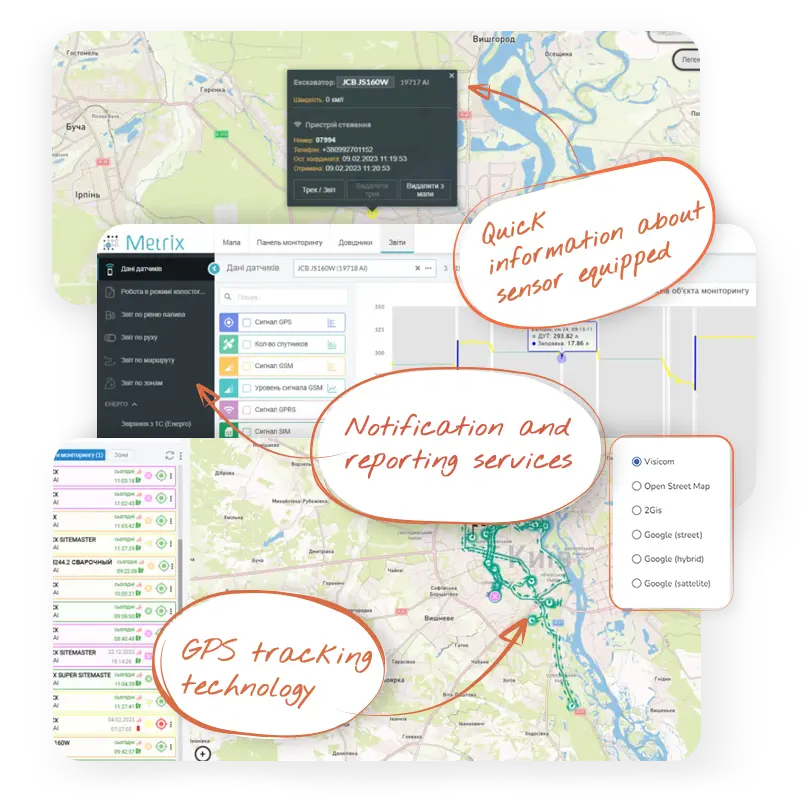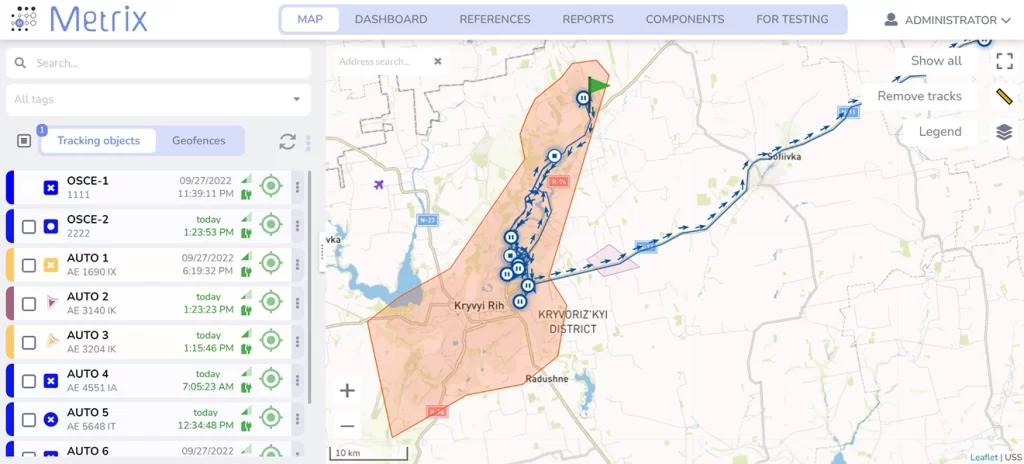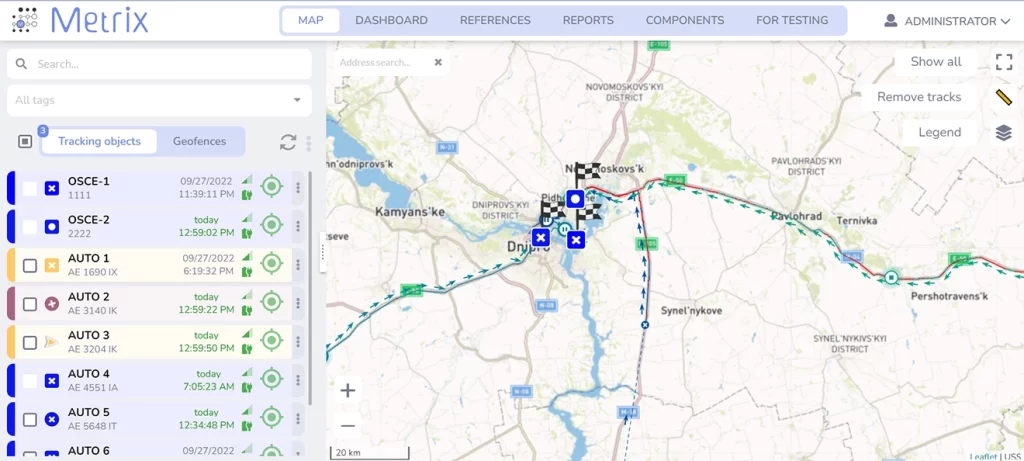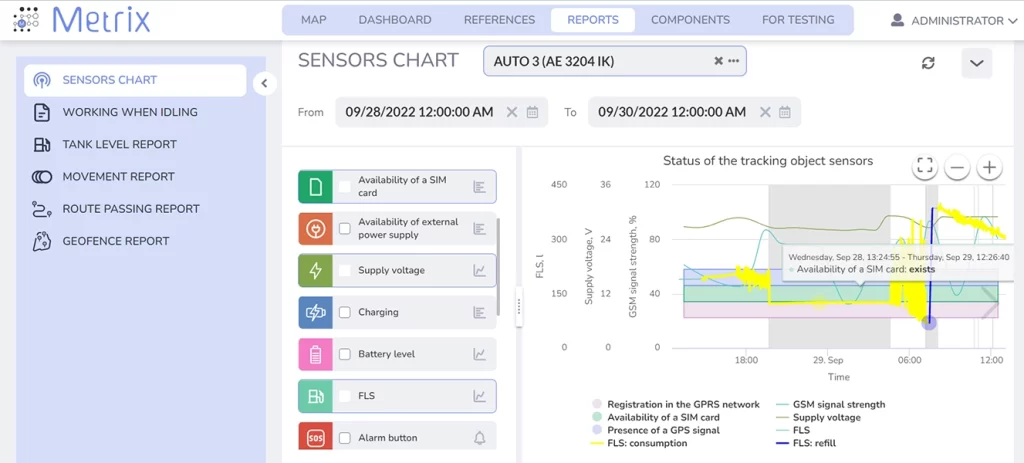Vehicle tracking systems have become increasingly popular in recent years, particularly in the transport and logistics industry. Real time vehicle tracking system is designed to monitor and track the movements of vehicles in real-time, providing businesses with valuable insights into the location, speed, and behavior of their vehicles and drivers. This information can be used to optimize routes, reduce fuel consumption, improve customer service, and increase overall operational efficiency.
What is a Real Time Vehicle Tracking System?
A realtime vehicle tracking system is a GPS-based technology that monitors the location and movements of vehicles in real-time. The system consists of a GPS device that is installed in each vehicle and a central control center that receives and processes the data from the GPS devices. The data is then displayed on a map, providing a clear visual representation of the location and movements of each vehicle.
In addition to GPS tracking, many real-time vehicle tracking systems also include additional features such as speed monitoring, route optimization, driver behavior analysis, and real-time notifications. These features can be customized to meet the specific needs of each business, making it easier to manage and optimize their fleet operations.

Benefits of Real-Time Vehicle Tracking Systems
There are many advantages of real time vehicle tracking. Among the major benefits are:
Improved Fleet Management
One of the primary benefits of real-time vehicle tracking systems is the improved management of fleets. With real-time information about the location, speed, and behavior of vehicles and drivers, businesses can make more informed decisions about route optimization, fuel consumption, and driver safety. This leads to increased efficiency and reduced operating costs.
Increased Customer Satisfaction
By providing real-time information about the location and estimated arrival time of vehicles, real-time vehicle tracking systems can help businesses improve customer satisfaction. This is particularly important in the transport and logistics industry, where customers are often concerned about the delivery time of their goods.
Improved Driver Safety
Real-time vehicle gps tracking systems can also help improve driver safety by providing businesses with valuable insights into driver behavior. This information can be used to identify risky driving practices, such as speeding, sudden braking, and sharp turns, and to provide drivers with feedback on how to improve their driving habits.
Reduced Fuel Consumption
Another key benefit of realtime vehicle tracking system is the reduction of fuel consumption. By optimizing routes, reducing idling time, and improving driving habits, businesses can reduce their fuel costs and lower their carbon footprint.
Key Features of Real Time Vehicle Tracking Systems:
Real-time vehicle tracking systems typically have several key features, including:
- GPS tracking: This allows you to track the location and movement of your vehicles in real-time.
- Geofencing: This feature allows you to define virtual boundaries on a map, and you will receive notifications when vehicles enter or leave these boundaries.
- Vehicle diagnostics: This includes monitoring of a vehicle's engine performance, fuel consumption, and other vital metrics.
- Alerts and notifications: This includes automatic notifications for events such as speeding, idling, or unexpected stops, which can help you keep your vehicles on track and reduce operational costs.
- Route optimization: This feature allows you to plan the most efficient route for your vehicles, taking into account factors such as traffic, road conditions, and other variables.
- Historical playback: This allows you to review the past movements and location history of your vehicles, helping you identify trends and improve your operations.
- Integration with other systems: Some real-time vehicle tracking systems can be integrated with other software, such as dispatch and scheduling systems, to provide a complete and centralized view of your fleet operations.

Types of Real-Time Vehicle Tracking Systems
There are several types of real time vehicle tracking systems. They are:
Passive Tracking Systems
Passive tracking systems store GPS data in the vehicle and download it at a later time. This type of system is ideal for businesses that do not require real-time tracking, or for those who have limited data transmission capabilities.
Active Tracking Systems
Active tracking systems transmit GPS data in real-time, providing businesses with a clear visual representation of the location and movements of each vehicle. This type of system is ideal for businesses that require real-time tracking, or for those who need to respond quickly to changes in vehicle locations or movements.
Hybrid Tracking Systems
Hybrid tracking systems combine the features of passive and active tracking systems, providing businesses with the benefits of both types of systems. This type of system is ideal for businesses that require a mix of real-time and historical tracking data.
Features to Look for When Purchasing a Real-Time Vehicle Tracking System
When purchasing a real-time vehicle tracking system, it is important to consider the following features:
Real-Time Location Tracking
The most important feature of a real-time vehicle tracking system is real-time location tracking. This allows fleet managers to monitor the real-time location of their vehicles and keep track of their movements.
Route Optimization
Route optimization is another important feature to look for in a real-time vehicle tracking system. This feature helps fleet managers to optimize routes, reducing fuel costs and increasing efficiency.
Geofencing
Geofencing allows fleet managers to set up virtual boundaries around specific areas, such as a customer's location or a work site. When a vehicle enters or leaves one of these boundaries, the tracking system sends an alert to the fleet manager.
Driver Behavior Monitoring
Driver behavior monitoring allows fleet managers to monitor the behavior of their drivers, such as excessive speeding or sudden stops. This information can be used to improve safety and reduce the risk of accidents.
Maintenance Monitoring
Maintenance monitoring is an important feature for fleet managers who want to keep track of their vehicles' maintenance schedules. This feature allows them to monitor the status of their vehicles and schedule maintenance as needed.
Integration with Other Software
Integration with other software is an important feature for fleet managers who want to use a comprehensive solution for fleet management. This feature allows the real-time vehicle tracking system to be integrated with dispatch and route planning systems, providing a complete solution for fleet management.
User-Friendly Interface
A user-friendly interface is critical for fleet managers who want to use the real-time vehicle tracking system effectively. The interface should be easy to use, with clear and concise information, and should be accessible from any device with an internet connection.
Real-time vehicle tracking systems are an essential aspect of fleet management, providing improved operations, safety, and customer service. When purchasing a real-time vehicle tracking system, it is important to consider features such as real-time location tracking, route optimization, geofencing, driver behavior monitoring, maintenance monitoring, integration with other software, and a user-friendly interface. By considering these features, fleet managers can find the right real-time vehicle tracking system to meet their needs and optimize their fleet operations.
Vehicle Tracking System Development
Vehicle tracking system development is the process of creating software and hardware solutions to track the location and movements of vehicles in real-time. The development of fleet tracking software involves the following steps:
Requirements Gathering and Analysis
The first step in vehicle tracking system development is to gather requirements and analyze the needs of the end-users. This involves understanding the business requirements, fleet operations, and the desired outcomes from the tracking system. The information gathered in this stage is used to define the specifications and requirements for the tracking system.
Design and Architecture
The next step is to design and architecture the system, which involves deciding on the hardware components, software architecture, and communication protocols. The design and architecture should be scalable and flexible, allowing for future updates and changes as required.
Development
The development stage involves the creation of the tracking system software, which can include a web application, mobile application, or a combination of both. This stage involves coding, testing, and debugging to ensure that the software functions as intended.
Hardware Integration
The next step is to integrate the hardware components, such as GPS devices and telematics devices, with the software. The hardware components provide the real-time location information to the software, allowing for real-time vehicle tracking.
Testing
Once the hardware and software have been integrated, the system is tested to ensure that it functions as expected. This includes functional testing, performance testing, and security testing to ensure that the system is secure and reliable.
Deployment
The final step is to deploy the system, which involves installing the hardware and software components in the vehicles and setting up the communication infrastructure. The deployment should be done in a manner that is quick and efficient, with minimal downtime.
Maintenance and Support
Once the system is deployed, ongoing maintenance and support is required to ensure that the system continues to function effectively. This includes software updates, hardware maintenance, and troubleshooting any issues that arise.
At A-Team Global we have helped the clients to reach their goal by implementing our custom-based IoT solution. One of our core focuses is fleet management software development. We can assist you in every stage of development and bring your project to a new level.
The development of vehicle tracking systems is a complex process that involves a range of hardware and software components. By following a structured approach, with clear requirements, design, and testing, it is possible to develop a vehicle tracking system that meets the needs of the end-users and provides real-time location information for vehicles. Ongoing maintenance and support are critical to ensuring the system continues to function effectively, providing valuable insights and operational efficiencies for fleet managers.
Reasons to Develop a GPS Vehicle Tracking System
There are several reasons why an organization might want to develop a GPS vehicle tracking system:
- Increased Efficiency: By tracking vehicles in real-time, organizations can optimize routes, reduce fuel consumption, and minimize downtime. This can result in significant cost savings and improved productivity.
- Improved Customer Service: With a GPS vehicle tracking system, organizations can provide their customers with up-to-date information on the location and status of their deliveries, improving customer satisfaction.
- Enhanced Fleet Management: With real-time visibility into the location and status of vehicles, fleet managers can make more informed decisions about dispatch and resource allocation, reducing waste and improving the overall efficiency of their operations.
- Improved Safety: GPS vehicle tracking systems can help organizations improve the safety of their drivers and vehicles by providing real-time information about the location and speed of vehicles, as well as alerts for potential hazards such as accidents or traffic congestion.
- Increased Security: GPS vehicle tracking systems can also help organizations improve the security of their vehicles by providing real-time information about their location, as well as alerts for potential theft or unauthorized use.
- Compliance with Regulations: For certain industries, such as commercial transportation and logistics, GPS vehicle tracking systems may be required by law to ensure compliance with regulations and safety standards.
Overall, a GPS vehicle tracking system can provide significant benefits to organizations of all sizes, helping them improve efficiency, customer service, fleet management, safety, security, and compliance with regulations.
Now let’s look more closely at the definition of GPS delivery tracking, main components of a vehicle's GPS tracking system, common way of how to build a GPS tracker, and the relationship between IoT and realtime vehicle tracking system.
GPS Delivery Tracking System
GPS delivery tracking is a system that uses Global Positioning System (GPS) technology to track and monitor the progress of deliveries in real-time. The system provides real-time updates on the location and status of deliveries, allowing customers and businesses to track their shipments and stay informed about their delivery status.
In a GPS delivery tracking system, a GPS device is installed in each delivery vehicle. This device sends data on the vehicle's location and speed to a central server, which can be accessed by customers and businesses through a web-based interface. The system can also provide notifications when a delivery is on its way, has arrived at its destination, or if there are any delays or issues with the delivery.
GPS delivery tracking systems can help improve delivery efficiency, reduce delivery times, and provide better customer service. They also provide businesses with valuable data and insights into delivery operations, allowing them to make informed decisions to improve their delivery processes.

Components of Vehicle's GPS Tracking System
A vehicle's GPS tracking system typically consists of the following components:
- GPS Receiver: This component receives satellite signals and uses triangulation to determine the exact location of the vehicle.
- Antenna: The GPS receiver is connected to an antenna that is mounted on the exterior of the vehicle. The antenna receives satellite signals and sends them to the receiver for processing.
- Main Control Unit: This component collects data from the GPS receiver and other sensors, such as accelerometers and gyroscopes, and processes it to determine the vehicle's position, speed, and direction.
- Data Storage: This component stores data collected by the main control unit. Some GPS tracking systems use internal memory, while others use external memory cards or cloud storage.
- Display Screen: This component provides a visual representation of the vehicle's location and other information. Some GPS tracking systems have built-in screens, while others use smartphones or computers to display information.
- Power Supply: This component provides power to the GPS tracking system. Some systems use batteries, while others are powered by the vehicle's electrical system.
- Communication Module: This component enables communication between the GPS tracking system and other devices, such as smartphones or computers. Communication is typically accomplished through Wi-Fi, Bluetooth, cellular networks, or a combination of these technologies.
- Sensors: Some GPS tracking systems include additional sensors, such as accelerometers and gyroscopes, to provide additional data about the vehicle's motion.
- Software: The GPS tracking system typically runs on embedded software that provides features such as real-time tracking, historical data analysis, and alerts. Some systems also have web-based or mobile applications for viewing data.
How to Build a GPS Tracker
If you wonder how to build a GPS tracker, here is the basic guideline. First and foremost, you'll need to gather several components and assemble them in a way that enables you to track the location of the device. Here's a basic outline of the steps involved:
- Choose a microcontroller: The microcontroller acts as the brain of the GPS tracker and is responsible for processing GPS data and transmitting it to a receiver. A popular choice for this is the Arduino.
- Obtain a GPS module: You'll need a GPS module that is compatible with the microcontroller you've chosen. The module should be able to receive and process GPS signals and output the location data in a format that the microcontroller can understand.
- Get a GSM module: A GSM (Global System for Mobile Communications) module allows the GPS tracker to send location data over the mobile network. Make sure to get a GSM module that is compatible with the microcontroller you're using.
- Connect the components: Connect the GPS and GSM modules to the microcontroller following the manufacturer's instructions. You'll also need to connect a power source, such as a battery, to the microcontroller.
- Write the code: Write the software code that will run on the microcontroller. The code should process the GPS data, format it, and send it over the GSM network to a receiving device. You can find sample code online that you can modify to suit your needs.
- Test and refine: Test the GPS tracker to make sure it's working correctly and sending accurate location data. Refine the code as necessary to improve the performance of the tracker.
- Enclose the components: Once everything is working correctly, you'll need to enclose the components in a case to protect them. You can either buy a ready-made case or create your own.
Now you have the basic idea about how to make a GPS tracker. Note that building a GPS tracker requires a certain level of technical expertise, particularly when it comes to writing the software code. If you're not comfortable with coding, you might want to consider buying a pre-made GPS tracker instead.
IoT and Real Time Vehicle Tracking System
IoT technology plays a crucial role in the functioning of a real-time vehicle tracking system. IoT devices, such as GPS trackers, can collect and transmit data from the vehicles to the central server in real-time, providing real-time information about the location, speed, and direction of each vehicle. This data can then be used to optimize fleet management, improve safety, and enhance customer service.
GPS (Global Positioning System) tracking and the Internet of Things (IoT) are related in that GPS technology can be used as a component in many IoT devices to provide location-based services. IoT refers to a network of physical devices, vehicles, home appliances, and other items embedded with electronics, software, sensors, and connectivity which enables these objects to connect and exchange data.
GPS tracking systems can be integrated into IoT devices to provide location information and enable real-time monitoring and control. For example, GPS tracking can be used in IoT devices such as fleet management systems for commercial vehicles, personal fitness tracking devices, and smart home security systems.
IoT devices can also collect and transmit data about their surroundings, such as temperature, humidity, and motion, which can be combined with GPS information to provide a more complete picture of the device's environment. The combination of GPS tracking and IoT technologies has many applications in various industries, such as transportation, healthcare, and agriculture, among others.
In addition to GPS tracking, real-time vehicle tracking systems can also incorporate other IoT devices, such as sensors and cameras, to collect data on a vehicle's speed, fuel consumption, and maintenance status. This data can then be used to optimize fleet management, reduce operational costs, and improve overall vehicle performance.
Overall, the integration of real-time vehicle tracking and IoT technology provides numerous benefits to organizations, including improved fleet management, enhanced safety, and reduced costs.

Conclusions
A real-time vehicle tracking system is a technology that allows you to track the location and movement of vehicles in real-time. This system uses GPS and other technologies to provide accurate and up-to-date information about a vehicle's location and movement. The system can be used in a variety of applications, including fleet management, logistics, and security.
Overall, realtime vehicle tracking systems can provide a wide range of benefits to companies, including increased efficiency, improved safety, enhanced customer service, and better fleet management.
you may also want to read

Leveraging Local LLMs and Secure Environments to Protect Sensitive Information
In the rapidly evolving digital landscape, businesses are increasingly adopting Generative AI (GenAI) technologies to stay competitive and innovate. Large...

Boost Efficiency Today: Easy AI Integration for Immediate Results
In the past, the idea of integrating artificial intelligence into your business might have felt like venturing into uncharted territory—complex,...

A Roadmap to Gen AI Adoption for Small and Medium Businesses
Unlock new opportunities by integrating Generative AI into your business operations. In today’s fast-paced digital landscape, small and medium businesses...
